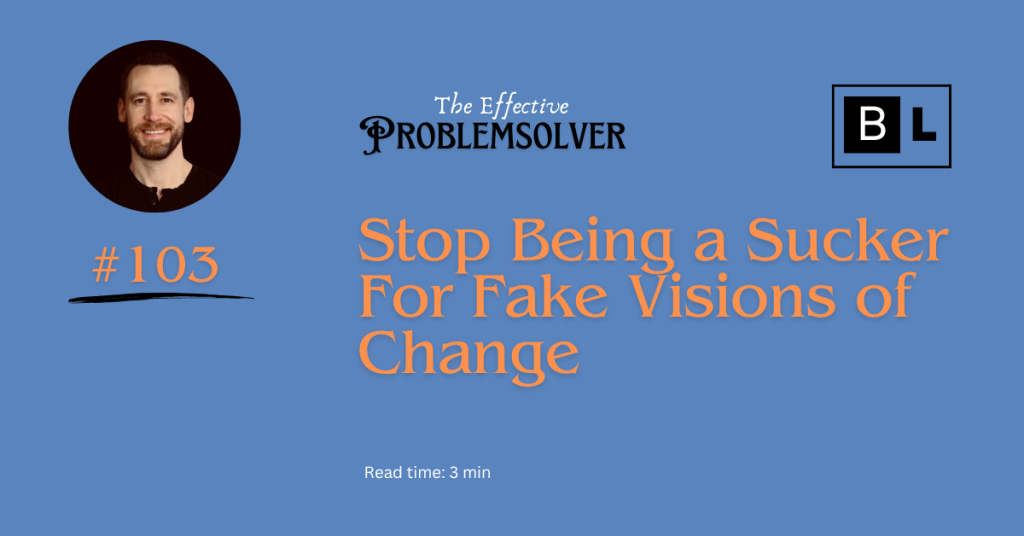THE EFFECTIVE PROBLEMSOLVER #103
Can I be brash and provocative for a moment?
Because in this field, we rarely admit an uncomfortable truth:
Too many of us spend our days as suckers.
Not because we’re bad or lazy—but because it feels good to believe what sounds good.
We get swept up in annual meetings, strategic plans, confident leaders with polished slides and big promises.
We repost their press releases. We like their posts on LinkedIn. We tell ourselves: “Yes, we’re part of something that’s changing the world.”
Even when, if we’re honest, the outcomes don’t budge.
Why do I say this? Because I’ve been that sucker.
Years ago, working in state government on policy, I saw it up close.
A new administration came in saying all the right things: a focus on outcomes, systems change, economic mobility.
They brought in communications consultants, lined up CEOs and the heads of our biggest higher education institutions.
I helped them: writing reports, preparing testimonies, polishing talking points.
For a while, I truly believed: “This time it’s different. This is real change.”
Then it became clear the story was advancing careers and headlines—not real results for people on the margins.
I learned the hard way: you can spend years polishing a narrative that goes nowhere.
Everyone falls for it sometimes.
The question is:
Who learns, and who keeps falling?
Taleb’s lens: suckers and non-suckers
In Nassim Nicholas Taleb’s framework, the “sucker–non‑sucker” distinction is a core idea.
A sucker is someone who gets caught up in stories, arguments, or heroic visions where the downside risk is huge.
A non-sucker focuses relentlessly on the payoff and consequences—minimizing risk, maximizing real‑world impact, and ignoring applause.
The non-sucker doesn’t waste time trying to look right or sound right.
They care about one thing:
Are we actually making things better—and at what cost?
A real-world case: Tipping Point’s Chronic Homelessness Initiative
In 2017, San Francisco had 2,112 people experiencing chronic homelessness.
Tipping Point Community launched the Chronic Homelessness Initiative (CHI) with a big, clear goal:
Halve chronic homelessness among individuals without children by January 2023, aiming to bring the number down to 1,056.
They raised $100 million, formed public–private partnerships, and won national attention.
It became a story of bold vision and civic leadership.
But by the city’s own numbers, between 2022 and 2024, chronic homelessness rose by 11%—to 2,989 people.
And 35% of the total homeless population remains chronically homeless, the same rate as before.
The narrative stayed strong. The numbers didn’t.
But what’s wrong with big dreams?
Why not try? Isn’t it better to aim high, even if we miss?
Here’s the catch:
Big dreams often maximize risk.
$100 million spent, countless hours invested—and no improvement.
A non-sucker wouldn’t bet everything on a single grand strategy.
They’d ask:
What’s the smallest, cheapest intervention that reliably improves outcomes?
They’d pilot, measure, adapt—and expand what works.
Instead, big initiatives promise massive success, gamble huge resources, and when they fail, the leaders still keep their jobs, reputations, and speaking slots.
The real harm falls on those with no voice: people experiencing homelessness, who needed real help—not a story.
You see, the wager was made by people leading respected nonprofits, celebrated in the press and invited onto big stages.
The risk—the pain of failure—landed on the homeless themselves.
Whenever someone can say, "I have a big vision, but if I fail, oh well, at least I tried"—you know they have no skin in the game.
And you’re a sucker if you believe them.
Why do so many stay suckers?
Because it feels better to look like we’re doing good than to face the scoreboard.
It feels easier to promote a shiny report than to ask, “Is this actually working?”
And the field quietly rewards those who play along.
In private, people admit doubts.
In public, they keep clapping.
Non-suckers do something different
They don’t chase applause or viral posts.
They measure relentlessly, adapt quickly, and test until something reliably works.
They don’t risk big dreams when failure would harm those they’re supposed to help.
They refuse to help spin a story when the reality underneath is stagnant.
A few uncomfortable questions:
- Are you promoting initiatives as “doing great work,” even if you haven’t seen convincing evidence?
- Are you rallying behind a glossy report because everyone else is—even when you suspect the numbers don’t add up?
- Are you believing people who say “things are really working”—when they’re too far from the front line to really know?
A final question
So: Are you a sucker or a non-sucker?
Not as an insult, but as an honest test.
Are you helping polish narratives because it feels good—or insisting on evidence, even when it feels lonely?
Everyone falls for a shiny story at least once.
The difference is: who keeps falling—and who learns?
I hope this unusually brash edition helped you ask that question.
Because in this work, we can’t afford more suckers.
We need people who care more about impact than image.
See you in two weeks.



